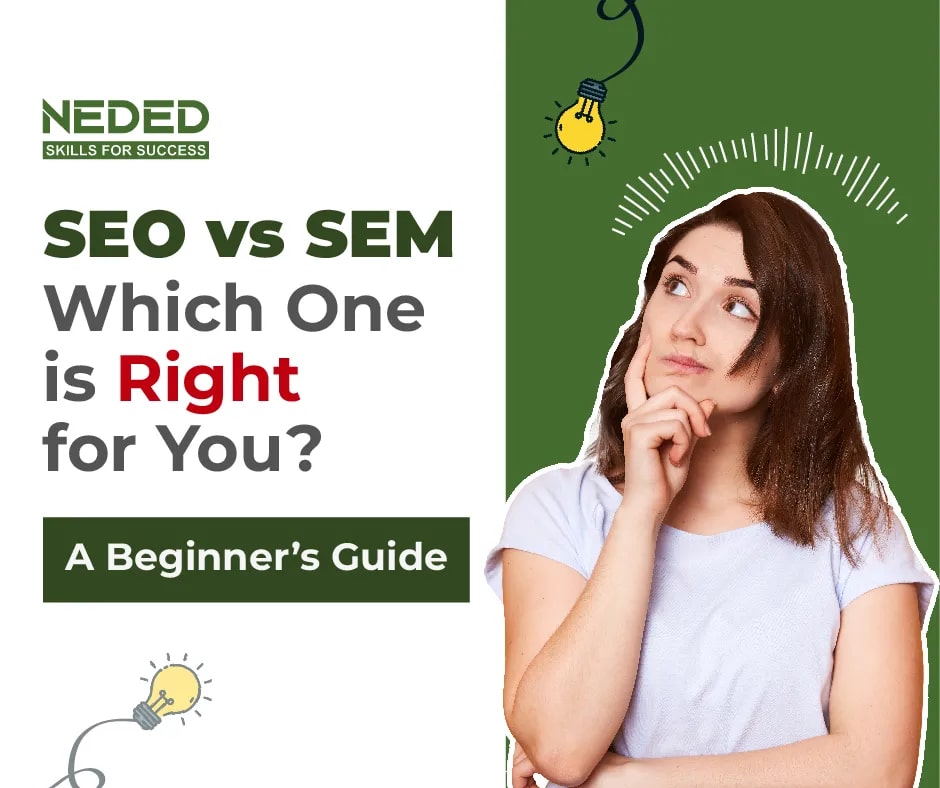SEO vs. SEM: Understanding the Differences and Benefits

In the digital marketing landscape, two powerful strategies drive website traffic and improve visibility: Search Engine Optimization (SEO) and Search Engine Marketing (SEM). While these terms are often used interchangeably, they serve distinct purposes and offer unique benefits. Understanding the differences between SEO and SEM can help businesses leverage both effectively for online success.
What is SEO?
Search Engine Optimization (SEO) is the practice of enhancing a website’s organic (non-paid) search rankings on search engines like Google. SEO involves optimizing various aspects of a website to make it more attractive to search engines and users alike.
Key Components of SEO:
1. On-Page SEO
• Keyword Research & Optimization – Using relevant keywords naturally in content, titles, and meta descriptions.
• Content Quality – Creating high-quality, valuable, and original content that satisfies user intent.
• Title Tags & Meta Descriptions – Optimizing HTML elements that describe a page’s content.
• URL Structure – Using clean, readable, and keyword-rich URLs.
• Internal Linking – Linking between pages within the same website to improve navigation and indexation.
• User Experience (UX) – Ensuring mobile-friendliness, fast loading times, and easy navigation.
2. Off-Page SEO
• Backlinks – Gaining high-quality inbound links from authoritative websites.
• Social Signals – Engaging with social media platforms to drive traffic and brand awareness.
• Brand Mentions – Getting cited on other websites, even without links.
• Influencer Outreach – Collaborating with influencers or industry leaders to gain credibility and visibility.
3. Technical SEO
• Website Speed Optimization – Ensuring fast loading times for better user experience and rankings.
• Mobile-Friendliness – Making the website responsive for mobile users.
• Structured Data (Schema Markup) – Using schema markup to enhance search engine understanding.
• XML Sitemap & Robots.txt – Assisting search engines in crawling and indexing website pages.
• HTTPS & Security – Securing the website with an SSL certificate to improve trust and rankings.
4. Local SEO
• Google My Business (GMB) Optimization – Ensuring your business appears in local searches.
• NAP Consistency – Keeping Name, Address, and Phone Number (NAP) information consistent across directories.
• Local Citations & Reviews – Encouraging customer reviews and listing the business in local directories.
• Geo-Targeted Keywords – Using location-specific keywords to rank for local searches.
5. Content Marketing & SEO
• Blogging & Articles – Regularly publishing informative, engaging content.
• Video & Multimedia Content – Using videos, images, and infographics to improve engagement.
• Evergreen & Trending Content – Balancing long-lasting and timely content for ongoing traffic.
Benefits of SEO:
1. Increased Website Traffic
• SEO helps rank higher in search engine results, leading to more organic traffic.
• Unlike paid ads, organic traffic is free and sustainable over time.
2. Better User Experience (UX)
• Optimizing for SEO also improves website speed, navigation, and mobile-friendliness.
• A well-structured website leads to lower bounce rates and higher engagement.
3. Higher Credibility & Trust
• Websites that rank higher in search results are perceived as more credible and authoritative.
• Google favors sites with quality content, strong backlinks, and good user experience.
4. Cost-Effective Marketing Strategy
• SEO is more affordable than paid advertising (like PPC) in the long run.
• Once a website ranks well, it continues to attract traffic without ongoing ad spend.
5. Competitive Advantage
• Businesses that invest in SEO outperform competitors who don’t optimize their websites.
• Ranking above competitors can lead to more leads, sales, and brand awareness.
6. Increased Conversions & Sales
• SEO helps attract highly targeted traffic, leading to better conversion rates.
• Users searching for specific products or services are more likely to make a purchase.
7. Local SEO Boosts Foot Traffic
• Optimizing for local searches helps businesses attract nearby customers.
• Google My Business (GMB) optimization leads to better visibility in Google Maps and local search results.
8. Long-Term Results
• Unlike paid ads that stop working when the budget runs out, SEO provides lasting benefits.
• Consistent efforts in content and optimization can keep a website ranking for years.
9. Enhances Content Marketing
• SEO and content marketing go hand in hand, ensuring your content reaches the right audience.
• Well-optimized blogs, videos, and infographics attract more traffic and shares.
10. Adapts to Consumer Behavior Trends
• SEO helps businesses stay ahead by understanding and targeting changing search trends.
• It provides insights into what potential customers are looking for and how they search.
• Long-Term Results – Organic rankings take time to build but provide lasting benefits.
• Cost-Effective – Unlike paid ads, SEO doesn’t require ongoing payments for traffic.
• Credibility & Trust – Higher organic rankings boost trust and credibility among users.
What is SEM?
Search Engine Marketing (SEM) is a broader term that includes both SEO and paid search strategies. However, in practice, SEM often refers specifically to paid advertising efforts, such as Pay-Per-Click (PPC) campaigns.
Key Components of SEM:
1. Paid Search Advertising (PPC - Pay-Per-Click)
• Google Ads, Bing Ads, and other search engine advertising platforms.
• Advertisers bid on keywords to show their ads at the top of search results.
• Advertisers pay only when users click on the ad.
2. Keyword Research & Targeting
• Identifying high-performing keywords with strong search intent.
• Using match types: broad match, phrase match, and exact match.
• Negative keywords to filter out irrelevant traffic.
3. Ad Copy & Landing Page Optimization
• Writing compelling ad headlines and descriptions.
• Using call-to-actions (CTAs) to encourage clicks.
• Optimizing landing pages for conversions and relevance.
4. Quality Score & Ad Rank
• Google assigns a Quality Score based on keyword relevance, ad copy, and landing page experience.
• Higher Quality Scores lower costs and improve ad placements.
5. Bidding Strategy & Budgeting
• CPC (Cost-Per-Click) and CPM (Cost-Per-Thousand-Impressions) models.
• Automated and manual bidding strategies to maximize ROI.
6. Ad Extensions
• Adding extra information like call buttons, site links, and location extensions.
• Enhances ad visibility and click-through rates.
7. Performance Tracking & Analytics
• Measuring impressions, clicks, conversions, and ROI using Google Analytics & Google Ads reports.
• A/B testing ad variations to optimize performance.
8. Remarketing & Retargeting
• Re-engaging users who previously visited the website but didn’t convert.
• Displaying tailored ads on other websites and platforms.
Benefits of SEM:
Instant Visibility & Traffic – Unlike SEO, SEM provides immediate results by placing ads at the top of search results.
✅ Highly Targeted Advertising – Ads reach users actively searching for specific products or services.
✅ Measurable & Trackable – Real-time analytics allow advertisers to monitor performance and adjust strategies.
✅ Cost Control & Flexibility – Set daily budgets and adjust bids based on performance.
✅ Improved Brand Awareness – Even if users don’t click, appearing at the top increases brand recognition.
✅ Better Conversion Rates – SEM targets users with high purchase intent, leading to better conversion rates.
SEO vs. SEM: Which One Should You Choose?
Both SEO and SEM have their place in a well-rounded digital marketing strategy. The right approach depends on business goals, budget, and timelines:
• For Long-Term Growth – Invest in SEO for sustainable, cost-effective traffic over time.
• For Quick Visibility – Use SEM to drive immediate traffic and test marketing strategies.
• For a Balanced Strategy – Combine SEO and SEM to maximize visibility and reach different audience segments.
Conclusion
SEO and SEM are both essential digital marketing strategies that work best when used together. While SEO focuses on long-term organic growth, SEM provides instant visibility through paid advertising. Businesses that integrate both strategies can achieve greater online success, ensuring a steady flow of traffic and conversions.
By understanding and leveraging the strengths of SEO and SEM, businesses can create a powerful marketing strategy that drives results and enhances their online presence.
About:Author
Aakash is a digital marketing expert specializing in SEO and SEM strategies. With a passion for optimizing websites and running high-converting ad campaigns, he helps businesses boost their online visibility and drive targeted traffic. Aakash stays ahead of industry trends, ensuring brands achieve sustainable growth through data-driven marketing. When he's not analyzing search algorithms, he enjoys exploring new digital tools and sharing insights through his blogs.
Related Discussions
- 10
Has writing for search engines killed, creativity, communication, common sense?
by Susan Reid 8 years ago
Has writing for search engines killed, creativity, communication, common sense?Same company. Same products/services. But opening new office (franchise) in new location. Being asked to make website for new branch 100% unique from "parent" branch site. Being told "we're not...
- 17
How Seo is important for website?
by jack002 14 years ago
Hi, what seo doing, how is importance.
- 4
SEO vs SEM - Choosing the right strategy for your brand:
by Arunas17 5 years ago
Search engine optimization is a very crucial digital marketing strategy to place your brand at the top of the search results. It helps in increased visibility to boost traffic to your site. Though this may seem straight forward, there are some drawbacks in this too. It takes a pretty long time for...
- 10
What are the general SEO techniques followed around hubpages?
by mistu4u 10 years ago
No theory, I want to know practically what course of action can really increase the traffic to my article i.e. what actions really SEO the articles? Fellow hubbers share your experience.
- 24
What are the basics of SEO that every website owner should know?
by Shil1978 11 years ago
What are the basics of SEO that every website owner should know?
- 12
SEO and Social Media?
by RyzeUp 8 years ago
SEO and Social Media?Just wondering what different ways you use social media to contribute to an SEO/ SEM campaign?






